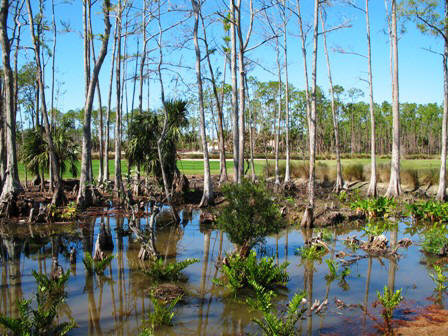Discover Florida Nature
It's time to explore the natural Florida


|
|
|
|
|
 Swamps
are part of the Freshwater Wetlands and Aquatic Ecosystem. Florida has
both the largest freshwater lake and the largest freshwater spring
(Wakulla Springs) in the contiguous United States. This makes Florida a
very rare state with a lot of aquatic diversity, from the mangroves that
prevent erosion to the swamps and marshes that naturally filter our
water. Freshwater swamps are generally wet, wooded areas where standing
water occurs for at least part of the year. Swamps
are part of the Freshwater Wetlands and Aquatic Ecosystem. Florida has
both the largest freshwater lake and the largest freshwater spring
(Wakulla Springs) in the contiguous United States. This makes Florida a
very rare state with a lot of aquatic diversity, from the mangroves that
prevent erosion to the swamps and marshes that naturally filter our
water. Freshwater swamps are generally wet, wooded areas where standing
water occurs for at least part of the year. Cypress swamps are the most common freshwater swamps in the state. They take the form of ponds or strands. Ponds have cypress trees growing in or around a depression. Viewed from a distance many ponds have a dome like appearance with the tallest trees near the center. Strands form in areas where the depression is longer than it is wide. Typically, the strand is long and narrow looking like a tree filled river and having the tallest trees in the deepest part of the depression. SUBSTRATE: Saturated with water for varying periods each year; amount of organic matter depends on length of saturation, source of water, and fire frequency. TOPOGRAPHY: Low-lying; along drainages, around lakes, and in small ponds. VEGETATION: About 100 species of trees, shrubs, and woody vines commonly found; river swamps most diverse and productive; cypress usually dominates in swamps with frequent fires and fluctuating water levels; high frequency of endemic epiphytes in south Florida swamps. FAUNA: Many invertebrate species; large and diverse fish populations in swamps adjacent to rivers and lakes; many common amphibians and some reptiles depend on swamps for reproduction; considerable diversity of birds and mammals; rare and endangered birds and mammals most likely to occur in cypress swamps and mixed hardwood swamps. PROCESSES / DYNAMICS / ABIOTIC FACTORS: Annual length of soil saturation, amount of organic matter accumulation in soil, source of water, and fire frequency determine major characteristics of Florida swamps. NEGATIVE IMPACTS: Drainage, filling, mining, logging, water pollution, invasion of human-introduced exotic plants such as Melaleuca; in south Florida, alteration of hydroperiod affects swamps rapidly and profoundly. The second type of inshore marine area consists of hard-bottom calcium carbonate rock, overlain by a thin layer of carbonate sediment. This habitat is most common in the southern portion of the bay and is home to sponges, octocorals and macroalgal patches. Here the macroalgae, present also in seagrass beds, form large unattached masses, collectively known as drift algae. The ability of the water in the Florida Bay estuary to support life is affected by a number of influences, including salinity and mercury, nitrogen, and phosphorus levels. "Inshore-dependent" species are those considered to be dependent upon inshore ecosystems for essential reproduction (as spawning or nursery areas), migration, or feeding. Moreover, without such critical inshore habitats, these species would not exist in the abundance they are (or were) found. Inshore marine habitats are unique and invaluable, nurturing many marine and freshwater species. |
|
|
Advertise | Privacy Statement | Dog Encyclopedia | Video |Contact | Alaska Nature |
|